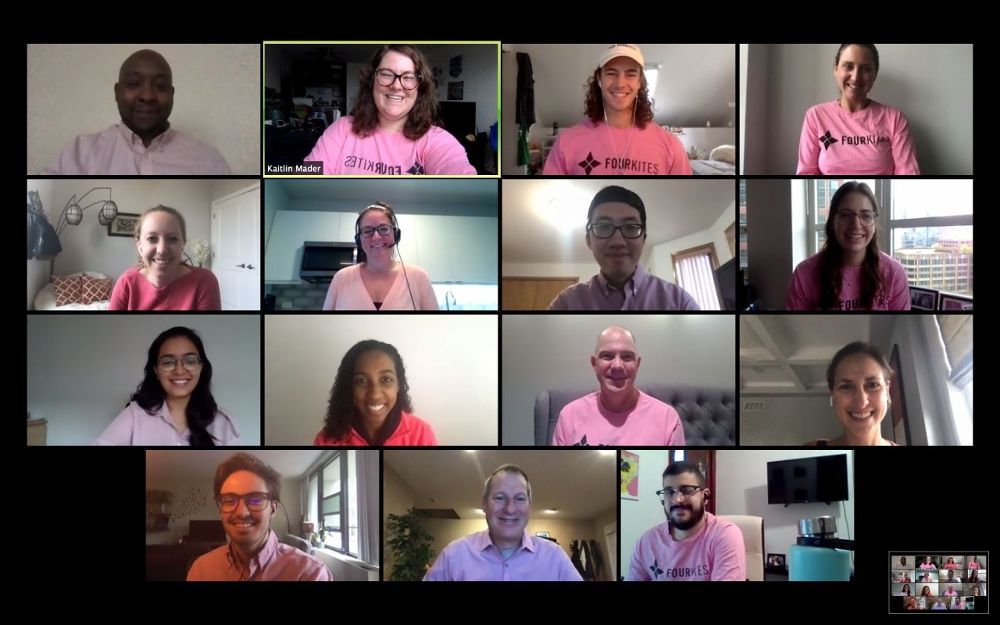How FourKites’ Single Pane of Glass Is Unique and Has Been Paying off Big Time
FourKites’ founder and CEO Mathew Joseph Elenjickal launched the business as his first startup after he graduated from Kellogg in 2014. At that time, transportation logistics is a huge, messy business, and the company is plunging in headfirst to make it a more efficient space. Today, it is re-shaping the logistics industry with nearly 500 employees worldwide, mostly in the Chicago headquarters and India office.
“Visibility is not a new thing – it has been around for ages. But real-time visibility only began in 2014. I feel really fortunate to have been able to drive that conversation forward,” said Elenjickal.
His first job out of school was at a consulting and software company, which hired him and gave him training in the supply chain. While he was sitting on the bench waiting for an assignment, an opportunity to work on a transportation-related project with Anheuser-Busch came along. The project turned out to be very successful and Elenjickal became “the transportation guy” in that way.
“Supply chain is fascinating. If you’re not in it, you tend to assume that supply chain is a well-oiled machine. But even now, there are Fortune 200 or Fortune 50 companies that don’t know where their trucks are! Even with all the advances we’ve made, there’s lots of room for improvement. So there are a lot of opportunities. If you’re intellectually curious, you can definitely make a mark,” Elenjickal inspired those who are starting a career in supply chain management.
Serve One Thing at First
To Elenjickal, when startups have early success, they tend to get stretched in a lot of directions. One customer can ask them to do a lot of things, and before they know it, they are solving many different pain points. According to Elenjickal, FourKites was very good early on at saying no.
A company can’t solve every problem for every consumer, especially when you are a startup with limited access to resources. It is crucial for startup founders to find the one thing that will bring value to their customers, and then focus on it. The fewer things that you establish, the easier it is to understand, act upon, and achieve success.
However, finding that one thing is extremely difficult as it requires absolute clarity and laser-sharp focus. “We stuck with that for the first three years of the company and didn’t do anything different. And that is very difficult for startups,” Elenjickal said. Eventually, the company focused on creating what was considered the best solution in the visibility space.
Once the early products focused on solving the pain points for full truckload shipments, new opportunities presented themselves as the customer base and the company grew. In doing so, FourKites now offers visibility solutions for less-than-truckload, rail, and intermodal operations. “At some point, you are going to capture the market, so where is the growth going to come from? You have to keep [investing] in new products,” Elenjickal said.
Data Is Everything
“The big difference with FourKites is that we aren’t just using data to run a business – that data is our business,” said Vivek Vaid, FourKites’ Chief Technology Officer. “It might not sound significant, but it completely changes how you think about the types of people you hire, the leadership structure, the operations model, the focus on data quality, and the overall level of data awareness across the organization.”
A passion for data and data science is built into FourKites’ DNA. From its inception, company leadership understood that data would be foundational to the vision of a future of automated, interconnected, and collaborative global supply chains.
FourKites has made significant investments in data quality best practices to help ensure that all of the data that its platform ingests is optimized for analysis and other sophisticated product capabilities. The company monitors data at an aggregate level and scrutinizes it at a unit level. It also uses advanced data science to help monitor data quality.
To Vaid, the most challenging aspect of working with all that data is making sure they can keep up with the amount of data they receive. It comes in 24 hours a day, seven days a week. Data platforms are hard because they have six or seven years of data stored there. Even if you have the funding, you can’t just get new people in and immediately start coding. It takes time to find the right people and to build a plan that is able to scale appropriately with organizations that may be 10 or 20 times your company’s size.
On the other hand, the most rewarding aspect is being able to give their customers the data-backed resources they need to make decisions that will allow them to operate efficient and cost-effective supply chains. “Technology now allows us to store immense amounts of data cheaply in the cloud, so we can help users make all the decisions they weren’t able to before. By streamlining those decision-making processes, our platform genuinely improves the lives of everyone involved in managing that supply chain – and that’s rewarding,” said Vaid.

It’s inevitable for today’s entrepreneurs to take data seriously as there’s a wide range of tools that offer historical and predictive data analyses. For organizations of all shapes and sizes, good data is the foundation of strong decision-making. The only problem is whether you are willing to take advantage of these available resources and face these daunting data dilemmas first-hand in the beginning.
FourKites’ initial product underwent some changes as new datasets emerged and its teams were tasked with interpreting that new data every single day. As far as the company has gone in five short years, there are more great things to come.
5 Ways to Successful Collaboration
Elenjickal launched the business as he graduated from Kellogg in 2014, since then, he has relied on a key principle he embraced at Kellogg: Collaboration. “Everything at Kellogg was team-oriented,” he said. “Case studies, even final exams. And the current crisis is highlighting the need for collaboration between companies.”
Elenjickal provides the example of Network Visibility, where supply chain partners can share information on the vendors and distributors in order to maximize efficiencies when it comes to planning and inventory management. He’s also helping to create industry councils and other groups to brainstorm supply chain strategies. At a high level, Elenjickal sees the supply chain as a team sport. “It’s about companies helping each other navigate this crisis and other problems,” he added.
To Elenjickal, it is relatively easy to track items from Point A to Point B, but there are things that happen before Point A and things that happen after Point B for that product. Different companies use different systems, and FourKites plays the role of the connective tissue, sitting on top of all these platforms. “We are building a network of shippers and carriers that allows us to build a better level of collaboration between companies,” he said.
That collaboration has allowed FourKites’ customers to get a better handle on its inventory because of the real-time visibility the platform offers. It continues to play a critical part in the company’s technology roadmap to innovate and deliver solutions that address the most pressing needs of its customers. And it is that depth of customer base that Elenjickal hopes will keep the FourKites story moving forward.

One of the greatest barriers in building collaboration is poor communication. As the logistics industry has become more and more decentralized, many organizations have developed proprietary workflows, processes, and systems that are largely unknown to those from the outside. Data is also critical to any effective collaboration. It facilitates efficient performance not only among individual team members but also across the entire company.
According to FourKites’ Director of Project Management and Network Collaboration Ryan Closser, there is no silver bullet to successful supply chain collaboration. Overcoming those barriers requires a long-term effort on both management and the workforce at large. His following recommendations would represent a strong first step on the road to reaping the benefits of improved collaboration for your business.
#1. Take Full Advantage of Your Existing Network
To Closser, if you are already actively collaborating with your vendors, suppliers, customers, and transportation partners, then discover new opportunities to do so more efficiently can improve customer satisfaction, operational efficiency, and operating costs. Keep it in mind to see every partner as an opportunity for collaboration and improvement.
#2. Break Down Data Siloes
Many attempts at supply chain collaboration are plagued by siloed data, incompatible systems, and informal processes that were never fully documented. To fix this, you need to centralize that data into a single system, which can be accessed easily by team members throughout the organization. This removes both technical incompatibilities and cross-functional dependencies, allowing all internal stakeholders to operate more autonomously and efficiently.
#3. Reach to Your Competitors
Industry success calls for data sharing among competitors, just because two companies exist in competition doesn’t mean their supply chains have to. In fact, there’s much to be gained when companies within the same industry engage in collaborative logistics, such as reducing dwell to improve available capacity throughout the industry, as Closser shares.
In April of this year, FourKites together with Tive and project44 have announced their partnership. The companies believe that collaboration and data sharing among different visibility providers is the only way to expand the breadth and depth of visibility within the industry as a whole.
In a model in which each company keeps its information to itself, data remains siloed and consumers ultimately pay the price. It is time for the collaboration to move past the point of individualism and competition, creating a collaborative space that makes room for everyone to succeed.

#4. Implement Collaborative Tools
Microsoft Excel may still be the most widely used TMS, but spreadsheets alone don’t cut it anymore. If you want to get ahead, you need to seek out tools and technologies that streamline outdated processes and eliminate all but the most necessary steps in a given process. Closser gives an example that implementing a single source for digital document transfer can boost not only efficiency but safety as well.
#5. Look For Communities to Join
Closser sees that many innovative new ideas are borne over cocktails or coffee at industry conferences and get-togethers. Professional communities like this offer a change of scenery, a fresh take, and new perspectives to bounce ideas off of. Even just because in-person events aren’t happening anymore doesn’t mean that you can’t still connect with people virtually and form a community that way.
Don’t Forget Sustainability
The Trump era had many sweeping policies and severe cutbacks on environmental initiatives, and the Biden administration is seeking to bring many of these areas back into US focus. Therefore, sustainability must become a part of the strategic intent of any organization, and from there, folded into the day-to-day operating model.
FourKites features a Sustainability Dashboard to show partners the environmental impact of their supply chain operations through visibility. In this area, data is one of the most important aspects in determining how much of an impact a company has on the environment and how to reduce it. However, this is one of the major pain points for the sustainability sector.
“Data availability is one of the biggest challenges in tackling sustainable logistics,” says Susie Bodnar, Director of Operations and Client Strategy, Predictive Capacity Management of FourKites. “Accurately measuring freight emissions, for instance, depends on several variables, including the type of load, equipment type, distance, and more. For many companies, the necessary data is only partially recorded, and much of it remains siloed in systems throughout the organization. Further complicating this is the fact that standard methodology for calculating emissions can vary from region to region.”
As Bodnar recommends, companies can mitigate this challenge by instituting systems to streamline and centralize data collection. Every supply chain professional can use the data in these systems to make more efficient choices within their everyday roles. Many companies increasingly have a sustainability team in place as well, that can own the data collection and calculations that will help them achieve their sustainability goals, Bodnar says.

Beyond data, technology has allowed sustainable practices to flourish with the modernization of trucking. Investment in these eco-friendly technological solutions can have up-front costs. However, it would eventually offer a significant return on investment in the long run by reducing continuous expenses that can add up like fuel.
If the past few years have taught us anything, it’s that unsustainable practices have severe consequences. Now that the supply chain is in the spotlight as the largest net emitter of greenhouse gases, the burden lies with logistics companies to not only protect their own businesses from market fluctuations but also minimize the impact on the entire world.
The Bottom Lines
In today’s fast-paced business landscape, this is no longer acceptable if you wish to achieve success without any effort. As a lot of things are changing in the market and a lot of data is becoming available in the logistics industry, it’s a great chance for startups to embark on this fascinating journey and learn new things every day.









